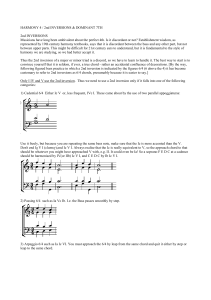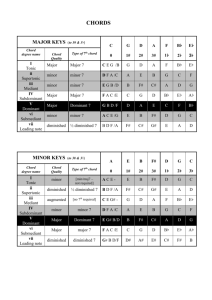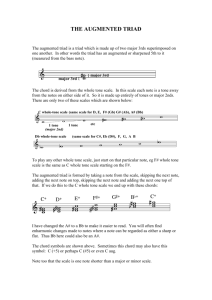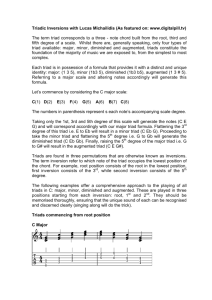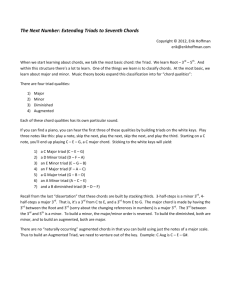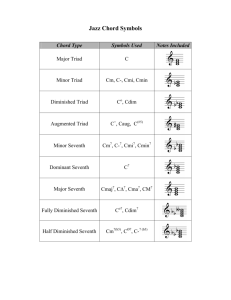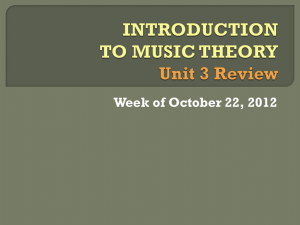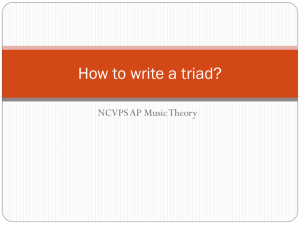Music Performance Review Sheet Scales: Summary: A scale is a
advertisement
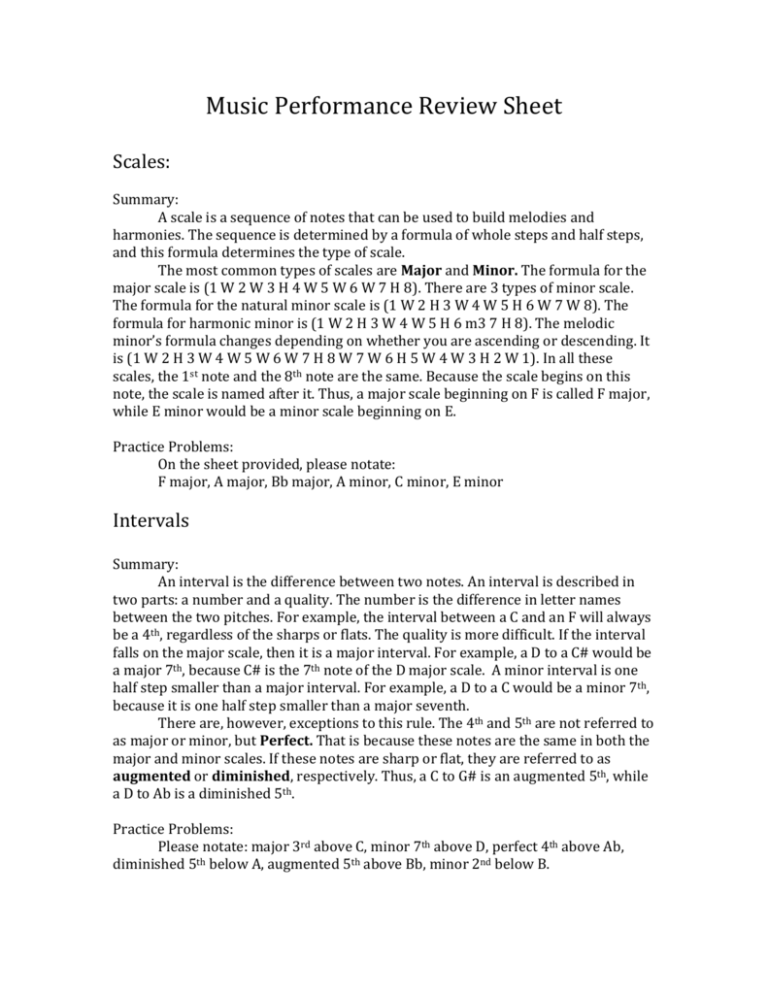
Music Performance Review Sheet Scales: Summary: A scale is a sequence of notes that can be used to build melodies and harmonies. The sequence is determined by a formula of whole steps and half steps, and this formula determines the type of scale. The most common types of scales are Major and Minor. The formula for the major scale is (1 W 2 W 3 H 4 W 5 W 6 W 7 H 8). There are 3 types of minor scale. The formula for the natural minor scale is (1 W 2 H 3 W 4 W 5 H 6 W 7 W 8). The formula for harmonic minor is (1 W 2 H 3 W 4 W 5 H 6 m3 7 H 8). The melodic minor’s formula changes depending on whether you are ascending or descending. It is (1 W 2 H 3 W 4 W 5 W 6 W 7 H 8 W 7 W 6 H 5 W 4 W 3 H 2 W 1). In all these scales, the 1st note and the 8th note are the same. Because the scale begins on this note, the scale is named after it. Thus, a major scale beginning on F is called F major, while E minor would be a minor scale beginning on E. Practice Problems: On the sheet provided, please notate: F major, A major, Bb major, A minor, C minor, E minor Intervals Summary: An interval is the difference between two notes. An interval is described in two parts: a number and a quality. The number is the difference in letter names between the two pitches. For example, the interval between a C and an F will always be a 4th, regardless of the sharps or flats. The quality is more difficult. If the interval falls on the major scale, then it is a major interval. For example, a D to a C# would be a major 7th, because C# is the 7th note of the D major scale. A minor interval is one half step smaller than a major interval. For example, a D to a C would be a minor 7th, because it is one half step smaller than a major seventh. There are, however, exceptions to this rule. The 4th and 5th are not referred to as major or minor, but Perfect. That is because these notes are the same in both the major and minor scales. If these notes are sharp or flat, they are referred to as augmented or diminished, respectively. Thus, a C to G# is an augmented 5th, while a D to Ab is a diminished 5th. Practice Problems: Please notate: major 3rd above C, minor 7th above D, perfect 4th above Ab, diminished 5th below A, augmented 5th above Bb, minor 2nd below B. Triads Summary: A triad is a chord composed of 3 notes. These notes are the root, third, and fifth note of a scale. A major triad is comprised of the root, 3rd, and 5th note of the major scale. Thus, Ab, C, and Eb compose an Ab major triad. A minor triad is comprised of the root, 3rd, and 5th note of the minor scale. Thus, Ab, Cb, and Eb comprise an Ab minor scale (notice that the 5th is the same, the only thing that changes is the middle note). A triad is augmented if the 5th is sharp and the 3rd is major (ie C, E, and G# are a C augmented triad). A triad is diminished if the 5th is flat and the 3rd is minor (ie D, F, and Ab are a D diminished triad). Practice problems: Notate the following triads. A major, Bb minor, B major, C diminished, Db augmented, G major. Sevenths Summary: A 7th is a 4 note chord, composed of the root, 3rd, 5th, and 7th notes of a scale. If the 3rd and 7th are from the major scale, the chord is called a major7 (so D, F#, A, C# is a D major7). If the 3rd and 7th are from the minor scale, the chord is a minor7 (so D, F, A, C is a D minor scale). If the 3rd is major and the 7th is minor, it is called a dominant7 (so D, F#, A, C is a D dominant7). Practice problems: Notate the following 7ths: D dominant, C major, Ab major, Bb minor, A dominant Inversions An inversion is when you change the bottom note of a chord. For example, to invert a C major chord (C,E,G), you could have the bottom note of the chord be E, so the chord would be E, G, C (note that the relative order does not change, i.e. E, C, G is incorrect because G no longer follows C). A chord is in 1st inversion if the bottom note is normally the 2nd note of the chord (for example, the first inversion of G, Bb, D would be Bb, D, G). The second inversion is when the note that’s typically 3rd is played on the bottom (so the 2nd inversion of Ab, C, Eb would be Eb, Ab, C). To notate these, you use a / to notate the bottom note. So a C/E would be E, G, C, because it is a C major chord with E on the bottom. Practice problems: Notate: C/E, Gm/Bb, Dm/F, Ab/Eb, Bmaj7/D#, Cm7/Bb

